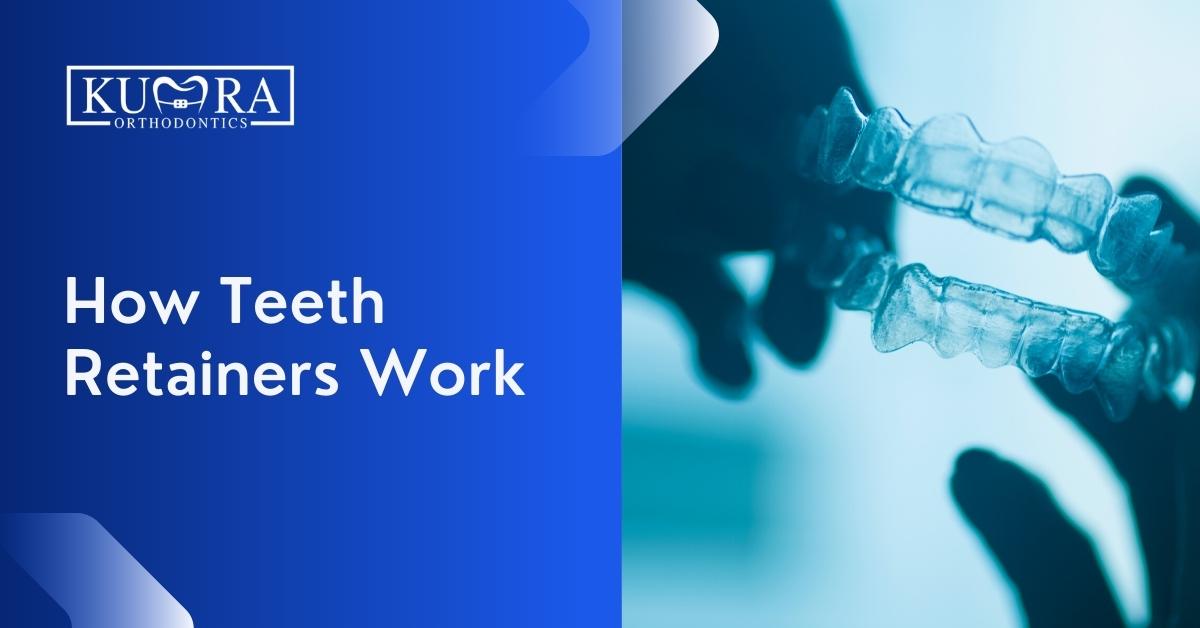Many individuals seek treatments to straighten their smile. However, not many are aware on how do retainers work. A retainer is a custom-made device for your teeth and can be made of plastic or wires. Its purpose is to keep your teeth from shifting by holding them together in place.
After having orthodontic treatment such as Invisalign, metal braces, or corrective surgery, most dentists and orthodontists will advise their patients to wear a retainer at all times to keep their teeth in their ideal position. It is possible that the new position of your teeth will not become permanent for up to six months, but in the majority of cases, you will need to wear a retainer for the rest of your life in order to keep the position of your teeth (but only at night).
How Retainers Work
A retainer will ensure that your teeth remain in their proper positions for a specific duration. If you have recently finished Invisalign treatment or had your braces removed, a retainer may be recommended to help keep your teeth in their new straight position. If you have an underbite or an overbite, your dentist or orthodontist may suggest wearing a retainer to help correct the problem. It is possible to improve the appearance of your smile by correcting the alignment and straightening of your teeth. Aligning the contour of your mouth, which is needed to help you enunciate words and make sounds, can also correct speech difficulties that you may have. This is done by aligning your teeth.
If you have problems with your speech or bite alignment, your dentist may recommend that you wear a retainer. For your dentist or orthodontist to properly fit you with a retainer, they will need to take impressions of your teeth, perform an oral exam, take intraoral photographs of your mouth, and maybe take x-rays. The information gathered will be used as the basis for the creation of a retainer.
Needing an orthodontic appointment?
Visit Kumra Orthodontics Washington, DC or Kumra Orthodontics Stafford, VA, and request an appointment with us!
Types of Retainers
Permanent and removable retainers are the two common types of retainers. A detachable retainer is composed of plastic or acrylic, whereas a permanent retainer is composed of metal, copper, or titanium wire. Removable clear plastic retainers can be worn for up to twenty years, whereas permanent retainers are worn indefinitely.
Permanent
Permanent retainers are the best option for patients who do not want to wear braces or undergo additional surgical procedures following their initial operation. They cannot be misplaced and are difficult to detect once they are in the mouth. However, it can be difficult to clean around them, which can result in tartar accumulation and gum disease. Even if you have a permanent retainer, there is still a chance that your teeth will shift.
Permanent Retainers
Permanent retainers are made up of a solid or braided wire bent to conform to the new shape of the patient’s teeth after they have been straightened. To prevent your front teeth from shifting, the wire will be connected to the inside of your teeth using dental cement. They are also known as fixed retainers, lingual wire retainers, or bonded retainers, and they are typically placed on the lower teeth. Only an orthodontist or a dentist can remove them from your teeth.
They are frequently used when an orthodontist believes that the teeth are very prone to relapse or when the person (such as a small kid) won’t follow the directions for using a removable retainer. In other words, they are used to permanently keep the teeth in the correct position. The majority of dental fillings are not removed at any point in time; those that are removed usually occur when there is an excessive accumulation of plaque and tartar or when there is sensitivity to the gums.
Removable
Customization is easier with removable retainers. They are frequently a well-liked alternative among young people. You may need to replace them on an annual basis, as needed, or whenever you lose them, which can become expensive. It is common for people to notice them more than permanent retainers, and they have the potential to be quite germy because of the accumulation of bacteria on them.
Hawley retainers
These removable retainers, also known as wire retainers, are constructed of thin metal wire and plastic or acrylic fashioned to suit the roof of your mouth or along the inside of your lower teeth. They are designed to keep your teeth in their proper alignment. In order to keep your teeth in proper alignment, the attached metal wire will run around the outside of your teeth.
Clear plastic retainers
These are retainers that can be removed and will properly match the new position of your teeth when they have been moved. Molded retainers are another name for these retainers. (You could also know them by their more technical name, thermoplastic or vacuum-formed retainers.)
In order to fabricate this kind of retainer, a mold of the patient’s teeth is first taken. After that, a very thin layer of plastic or polyurethane is heated and pulled down into the mold as it rotates.
Related: Why Your Retainers Smell and How to Deep Clean Them
Duration of Use
Your dentist may recommend either a detachable or a fixed retainer for you, depending on the condition of your teeth and gums. Or, your orthodontist may suggest wearing braces on both sets of teeth, one set on the top teeth and the other set on the lower teeth. According to the American Association of Orthodontics, your orthodontist will tell you when and for how long you need to wear the retainer in order to achieve the best possible results, regardless of the type of retainer you choose to wear (AAO).
Removable Retainer
After having braces put on, you will normally be required to wear this retainer around the clock for anywhere from four months to a year, taking it out to eat or brush your teeth. After the allotted amount of time, your orthodontist will evaluate whether you need to continue wearing your retainer for a longer period of time.
Even if your orthodontist finds no evidence of tooth movement as a result of the time you spend wearing your retainer, they may still advise you to wear it while you sleep to provide additional peace of mind that your newly straightened teeth will remain in their new position. This could be the case for the next few months, years, or possibly even forever, depending on the condition of your teeth.
Fixed Retainer
With a fixed retainer, you do not need to keep track of it or remember to insert it after eating or brushing your teeth. This retainer, bonded to your teeth in an inconspicuous area (often the back of your teeth), may need to be worn for a longer period, possibly even years.
Because a fixed retainer cannot be removed when eating, there is a possibility that periodontal problems will develop if adequate oral hygiene practices are not followed. However, because it continually maintains the stability of your teeth, there is a larger likelihood of retaining all of the benefits that your braces offer.
Related: Orthodontic Retainer Replacement: Steps, Signs & Costs
How to Clean Your Retainer
Maintaining cleanliness with retainers is essential for optimal dental health. It is recommended that a person inquires with their dentist or orthodontist regarding the precise cleaning guidelines for their retainers.
The directions for cleaning a retainer may be different for each type of retainer that a person has. In the case of removable retainers, the recommended cleaning method may include giving the retainer a thorough brushing with a toothbrush and toothpaste both before and after it is used.
On the other hand, cleaning a permanent retainer could prove to be more challenging. People with bonded retainers should brush them as part of their regular oral care program, and floss threaders may make flossing easier.
Gingivitis and cavities can both be avoided by practicing proper oral hygiene.
Read more: A Helpful Guide on How to Fix Underbites
Consult with Kumra Orthodontics to Learn More About How Retainers Work
Retainers are an important part of orthodontic treatment, and there are different types to choose from. Talk to your orthodontist about the best type for you and how often you will need to wear it. Remember that retainers require maintenance in order to keep your teeth straight, so be prepared to spend some time and effort on them. For more information about retainers and how they work, contact Kumra Orthodontics today.



